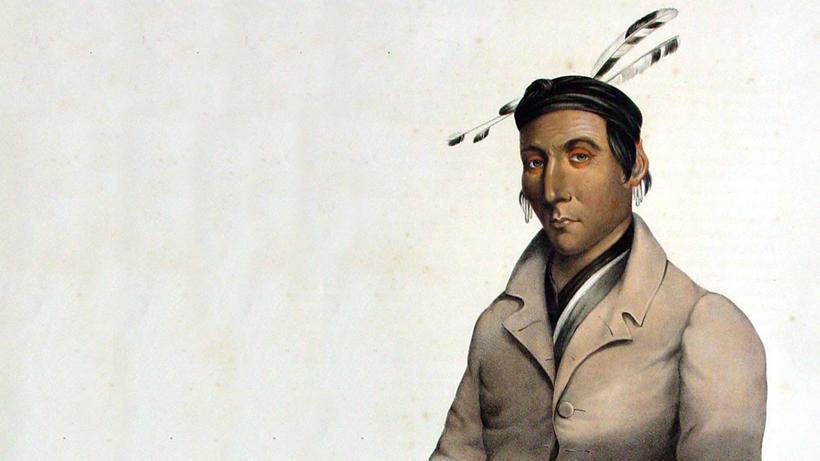Ka-Ta-Wa-Be-Da, Ojibwe

Katawabeda was the son of Biauswah II. He inherited his father’s chieftainship of the Sandy Lake Band and became the first “general ruler” the Minnesota Ojibways ever had. His daugher Mahnun married the renowned Hole-In-The-Day, the elder and she was the mother of the even more famous Hole-In-The-Day, the younger.
According to his own account, Katawabeda was a small boy when the Ojibways captured the British held Fort Michilimackinac in 1763 during the Pontiac War. He was among the Sandy Lake Chippewa and mentioned as an important person by Jean Baptiste Perrault in 1758. He had in his possession a french flag which in the “old days” had been presented to his ancestors by the French. In the winter of 1805-6 Lieutenant Zebulon Pike, U.S. Army, presented Katawabeda with an important official document. During the Cass expedition, 1820, James Doty (later Governor of the Wisconsin territory) made a survey of the Upper Mississippi Chippewa. In a report to Lewis Cass, (then Governor of the Michigan territory) Doty describes the various Chippewa bands at: Leech Lake, Sandy Lake, Pokegama, Rice Lake, Fond du Lac, Snake River, etc., listing civil and military chiefs of the bands, all of whom, he states: “are severally influenced by the Brachu, (Bre’che) who, it seems raised himself to this superior station merely by his eloquence. His ancestors have always been in good standing, and for a time furnished chiefs for the tribe at Sandy Lake. It appears he (Katawabeda) is the first Emperor of these tribes, they having been entirely distinct and independent previous to his time."
Henry R. Schoolcraft, Indian Agent for the Lake Superior District, reports a visit to the agency at St. Mary’s by this chief in 1822. He says, “I received a visit from Katawabeda, or Broken Tooth, chief of Sandy Lake, on the Upper Mississippi, who is generally known by his French name of Breshieu.”
Katawabeda and his son-in-law, Hole-in-the-day, the elder was in attendance at the historic and picturesque treaty of Prairie du Chien in 1825 at which council, Governor Lewis Cass and General William Clark attempted to solve the boundary disputes between the Chippewa and Sioux; and between the Sac, Fox, and Iowa’s confederacy and the Sioux.
He again was present in his official capacity at the treaty of Fond du Lac (Lake Superior) in 1826, a treaty to define boundaries between the Chippewa and Winnebagoes.
The Bre’che again visited the agency at the Sault in July of 1828. Schoolcraft records: “This venerable chief is the patriarch of the region around Sandy Lake, on the Upper Mississippi.”…and comments on a speech made by the chief: “The neutral policy which this chief so early unfolded, I have found quite characteristic of his oratory, though his political feelings are known to be favorable, decidedly, to the British Government.”…(the Bre’che’s son-in-law was George Ermatinger, a British trader from Canada).
When Schoolcraft headed his expedition to discover the source of the Mississippi River (Itasca Lake) in 1832, he held a council with the Upper Mississippi Chippewa at the mouth of the Crow Wing River. Here he learned of the death of Katawabeda, (during the winter of
1831-32).
No other Chippewa chief succeeded to the station held by Broken Tooth. He had been “Emperor” of the Chippewa realms on the Upper Mississippi from the Bois Brule on the south shore of Lake Superior, west to the Red River, and from the Canadian border lakes, south to the contested Chippewa-Sioux boundary north of the St. Peters (Minnesota) River.
